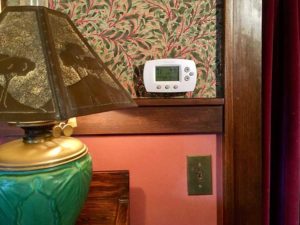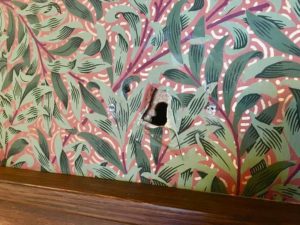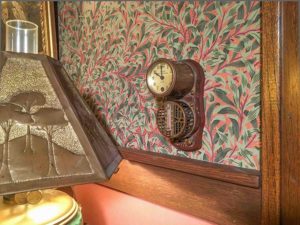Small Home Gazette, Spring 2017
Heat Exchange
On a bitterly cold Sunday evening this past winter, we came home after a weekend away to find the temperature in my bungalow’s dining room to be 38 degrees Fahrenheit. I recall thinking, as I stared in amazement at the thermometer, that 38 degrees feels far colder in one’s dining room than it does outdoors.
We made several attempts to re-ignite the furnace, then had a midnight visit by a weary repairman. But the 20-year-old unit was toast. Two days later I had a new furnace in my bungalow and a $5,000+ hole in my bank account.

The former thermostat, while functional, didn’t exactly blend well with my my vintage woodwork, furniture and art objects.
Thermostat Migration
But there were upsides to the experience. I took the opportunity to have the bungalow’s thermostat relocated—something I’d wanted since I moved in. The thermostat was on the interior wall of my dining room. I hated having a white, plastic, digital box mounted on my Bradbury & Bradbury wallpaper, next to the original oak trim. It was a glaring anachronism in my otherwise vintage rooms.
 So when the workers from Standard Heating & Air Conditioning arrived to install the new furnace, I asked if they could move the thermostat just through the doorway into the short hall that leads to the bathroom and two bedrooms. No problem, they said. No rewiring needed, just a small hole punched in the plaster on the opposite side of the wall, and the wires pulled through. Of course, that left a hole in the Bradbury & Bradbury wallpaper.
So when the workers from Standard Heating & Air Conditioning arrived to install the new furnace, I asked if they could move the thermostat just through the doorway into the short hall that leads to the bathroom and two bedrooms. No problem, they said. No rewiring needed, just a small hole punched in the plaster on the opposite side of the wall, and the wires pulled through. Of course, that left a hole in the Bradbury & Bradbury wallpaper.
A Better Fit
To cover the hole, I hung a vintage 1925 Minneapolis-Honeywell Regulator Co. thermostat. Needless to say, it looks right at home in my 1926 bungalow.

The vintage 1925 Honeywell thermostat looks right at home in its surroundings. The new, high-tech, functional thermostat is on the opposite side of the wall.
The thermostat is in mint condition, and, in theory, I could have used it to control my new furnace. It’s a beautiful piece of engineering, and it’s got a feature that surprised me: an automatic temperature setback, controlled by an integrated, eight-day, key-wound clock.
But my bungalow now has central air conditioning, and the old thermostat is not capable of controlling both heating and cooling. In addition, modern thermostats are much better at keeping a home’s rooms at a consistent temperature, especially paired with a forced-air furnace.
Lessons Learned
I learned a few things during the process of replacing my furnace that might be useful for others facing the same situation.
First: Brace yourself—they’re expensive. According to HomeAdvisor.com, the average cost of installing a new furnace in Minneapolis-St. Paul is $4,644, with most homeowners spending between $3,148 and $6,191 (tinyurl.com/kpfks8r).
Second: By law, virtually all furnaces now sold in Minnesota are high efficiency. This is good for the Earth, as less carbon dioxide is pumped into the atmosphere. Plus fuel costs are lower. The downside is that the super-efficient combustion chews through the unit’s gas manifold faster. The days of a furnace lasting 30 years or longer are gone.
Third: If you pay more, your house will be quieter and more comfortable. The lowest cost model offered to me had a single-level burner and a one-speed, on-or-off fan. The mid-level model had a single-level burner and a variable speed fan. The top model had a two-level burner and a variable speed fan. More burner levels and fan speeds mean the furnace runs quieter and the temperature is more consistent and comfortable. My old furnace was the low-end type, and the new furnace is the high-end type. There’s a significant difference. If you can afford it, go high-end.
Fourth: My new furnace, a Bryant brand, came with an internet-connected thermostat with a touchscreen interface that allows for detailed programming of heating and cooling schedules. Though there was an initial learning curve, it is now set so that we rarely need to manually adjust it. Energy isn’t wasted heating or cooling the house when we’re away or asleep, but the house is at a comfortable temperature the minute we arrive home or when the morning alarm goes off.
There’s also a smartphone app that displays an exact replica of the wall thermostat’s touchscreen. If necessary, we can remotely adjust all aspects of the furnace’s functions from anywhere.
Though the unexpected cost of my new furnace was a shock, we’re now enjoying stable, unobtrusive heat. And I love the look of the vintage thermostat on my dining room wall.











